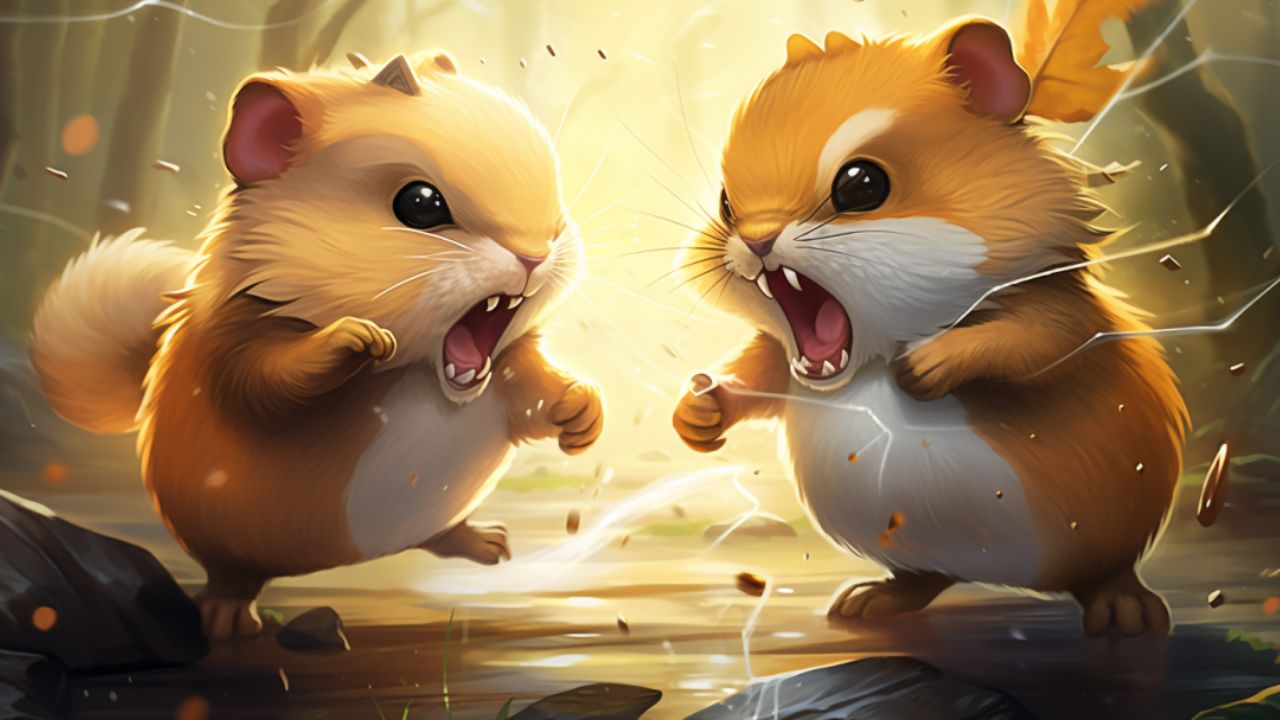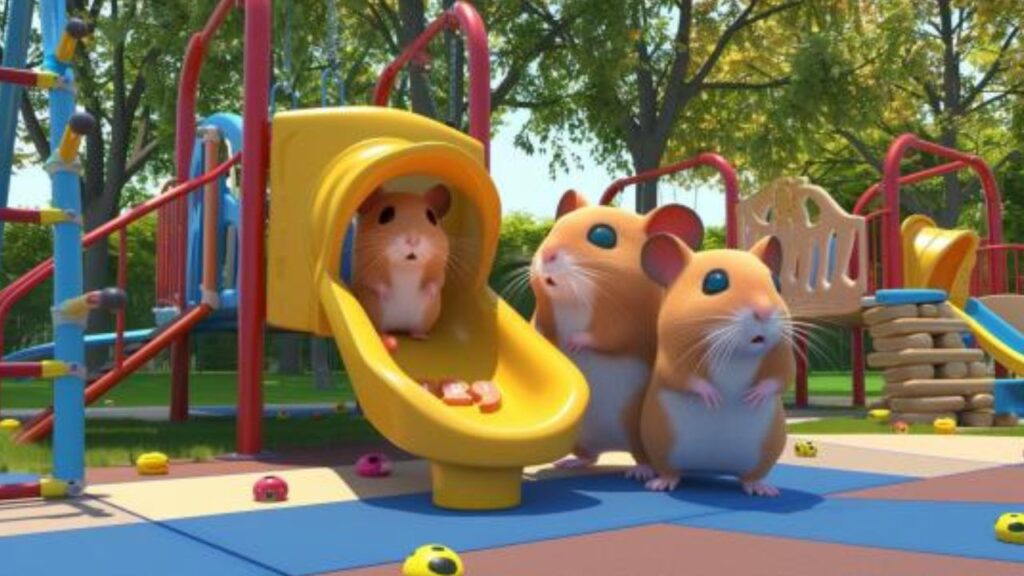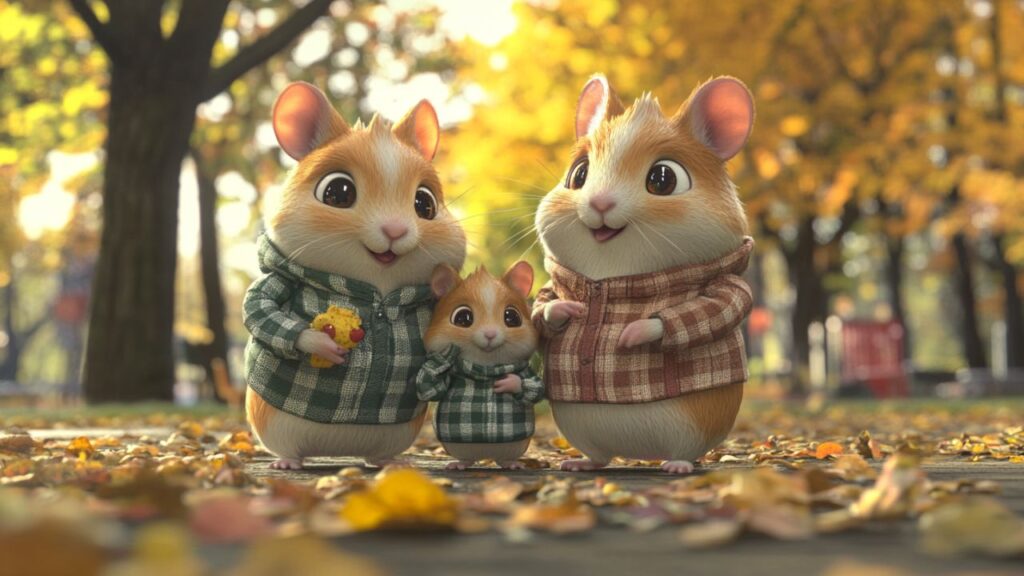The sight of tiny, wriggly baby hamsters cuddled together is undoubtedly heartwarming. Many hamster enthusiasts have been enchanted by the idea of breeding their little furballs, thinking of the adorable offspring and the opportunity to witness the magic of birth. But beyond the undeniable cuteness, hamster breeding carries a depth of responsibility. Breeding these little creatures is not just about multiplying their numbers; it’s about ensuring a safe, healthy, and ethically considered propagation.
Responsibilities Behind the Cuteness
Before diving deep into the world of hamster breeding, it’s essential to understand the magnitude of commitment required. The process goes well beyond simply pairing a male and a female. It encompasses understanding their genetics, ensuring their health, creating a conducive environment, and, most importantly, being prepared for potential challenges. This article aims to guide you through the nuances of hamster breeding, from the ethical considerations to the nitty-gritty details of care.
Navigating This Comprehensive Guide
In the following sections, Dr. Vivian Whiskerson, a renowned expert in the field, will impart essential knowledge on Hamster Breeding Tips. We will discuss the prerequisites of breeding, the ethical decisions involved, potential challenges, and the steps to ensure the health and well-being of both the mother and the pups. Whether you’re a seasoned breeder looking to brush up on your knowledge or a novice pondering the idea, this guide is tailored to provide insights that cater to various levels of experience. So, let’s embark on this enlightening journey, understanding the intricacies of bringing new hamster life into the world.
Breeding Preparedness

Breeding hamsters is not as simple as just putting two of the opposite sex together in a cage. There are nuances to consider, especially when it comes to understanding the right age for breeding and recognizing when a female hamster is receptive to a mate. Let’s delve deeper into these aspects to ensure you’re adequately informed.
Understanding Hamster Maturity and Breeding Age
When it comes to breeding, age isn’t just a number. It plays a pivotal role in ensuring the health of both the parents and the offspring. Here’s what you need to know:
- Maturity Onset: Hamsters reach sexual maturity rapidly. For instance, Syrian hamsters, one of the most popular breeds, can become sexually mature as early as 4 to 5 weeks of age. Dwarf hamsters, on the other hand, might reach maturity around the same time or slightly later.
- Ideal Breeding Age: Just because a hamster is mature doesn’t mean it’s the best time to breed. For Syrian hamsters, the prime breeding age is between 4 to 6 months. After this window, especially post the age of one year, complications can arise. Dwarf hamsters have a similar prime breeding window.
- Age-related Concerns: Breeding a hamster too early can lead to complications for the mother, such as difficulty during labor. On the flip side, older hamsters might face increased risks during pregnancy and might not be as fertile.
Recognizing the Signs of a Hamster in Heat
Identifying when a female hamster is in estrus (commonly referred to as being “in heat”) is crucial for successful breeding. Here’s how you can recognize the signs:
- Frequency: Female hamsters come into heat quite frequently. For Syrian hamsters, it’s every 4 days, while Dwarf hamsters might exhibit signs every few days.
- Physical Indications: A clear sign of a hamster in heat is a swollen and reddened vulva. There might also be a mild, musky odor which is a pheromone meant to attract potential mates.
- Behavioral Cues: Female hamsters in heat might become more active, running around more than usual. They might also assume a particular stance when touched, raising their hindquarters and freezing in place. This behavior is known as “lordosis.”
- Auditory Hints: Some hamsters might become more vocal during their heat cycles, emitting soft chirps or squeaks.
Understanding these signs can aid in optimizing the breeding process, ensuring a higher likelihood of pregnancy and reducing undue stress on the animals.
Remember, while knowledge of these aspects is crucial, it’s equally important to understand that breeding isn’t always successful on the first try. It requires patience, observation, and, most importantly, an emphasis on the well-being of the hamsters involved.
Ethical Considerations

Breeding animals, including hamsters, isn’t just about the technicalities; it delves deep into ethical realms. It’s essential for potential breeders to introspect and ensure they’re making informed decisions that prioritize the welfare of the animals. This section highlights some of the critical ethical considerations to keep in mind.
The Importance of Breeding for the Right Reasons
Breeding hamsters shouldn’t be a whimsical decision influenced by the allure of baby hamsters or potential financial gains. Here are some guiding principles:
- Welfare First: Breeding should prioritize the health and well-being of both the parent hamsters and the offspring. This includes ensuring proper medical care, adequate living conditions, and nutrition.
- Educate Yourself: Before embarking on the breeding journey, it’s essential to be well-informed. This encompasses understanding genetics, potential health issues, and the commitment involved in raising a litter.
- Avoid Impulse: Breeding shouldn’t be an impulsive decision based on how adorable baby hamsters are. Remember, these babies grow up and will have needs that last their entire lifetimes, which can span a few years.
Overpopulation and Adoption Concerns
One of the most pressing ethical issues in the realm of pet breeding is overpopulation:
- Pet Overpopulation: It’s a sad reality that many pets, including hamsters, end up in shelters or are abandoned. Breeding without a plan can contribute to this problem. Each new litter means more hamsters that need homes. Can you ensure that each one will have a loving, permanent residence?
- Adoption First: With many hamsters already waiting in rescues and shelters for homes, it’s worth considering the ethics of bringing more into the world. Promoting adoption can help reduce the number of animals in shelters.
- Unplanned Litters: Accidents happen, but they can lead to unplanned litters that strain resources and contribute to the overpopulation issue. Before breeding, have a clear plan for potential homes, and be prepared for larger litters than expected.
- Health Concerns: Breeding without understanding genetics can lead to offspring with health problems. This not only affects the quality of life for the hamster but can also result in significant vet bills for unsuspecting adopters or buyers.
In conclusion, the decision to breed hamsters should never be taken lightly. It’s not just about the mechanics of breeding but about understanding the larger implications for the animals and the broader pet community. Breeding ethically means prioritizing the health, safety, and well-being of the hamsters above all else.
Challenges in Hamster Breeding

Breeding hamsters, like breeding any other animal, isn’t without its complications. While the idea of cute baby hamsters might be tempting, the process isn’t always straightforward. From potential risks to the mother and pups to complications during pregnancy, breeding hamsters requires knowledge, preparation, and a readiness to face challenges.
Risks Involved for the Mother and Pups
The process of giving birth and the subsequent rearing of pups can be taxing on the mother hamster. Some of the associated risks include:
- Maternal Stress: Pregnancy and caring for pups can be a stressful experience for hamsters, especially if they are first-time mothers. This stress can sometimes lead to mothers neglecting or, in extreme cases, cannibalizing their offspring.
- Nutritional Needs: Pregnant and nursing hamsters have heightened nutritional requirements. If these aren’t met, it can negatively impact both the mother and the pups’ health.
- Inexperienced Mothers: Especially in cases where the mother is young or has never given birth before, there’s a risk that she may not instinctively know how to care for her pups, leading to neglect.
- Sibling Aggression: As pups grow, there might be signs of aggression or dominance, especially in confined spaces. This can lead to injuries if not closely monitored.
Potential Complications During Pregnancy
Hamster pregnancy, while often smooth, can sometimes face complications that breeders need to be aware of:
- Prolonged Labor: If a hamster is in labor for an extended period without producing pups, it could indicate a problem. In such cases, the intervention of a veterinarian might be necessary.
- Miscarriage: Various factors, such as stress, illness, or poor nutrition, can lead to a hamster miscarrying.
- Dystocia: This is a condition where the mother hamster has difficulty giving birth. It can be due to oversized pups or a misaligned birthing canal, necessitating veterinary intervention.
- Postpartum Complications: After giving birth, hamsters can face complications like infections or hemorrhaging. Monitoring the mother’s behavior and health closely post-birth is crucial.
In summary, while hamster breeding can be a rewarding experience, it’s essential to be aware of the potential challenges. Proper education, preparation, and a genuine commitment to the well-being of the animals can help mitigate many of these risks, but breeders must be prepared for unexpected complications and act swiftly to address any issues that arise.
Providing an Optimal Breeding Environment

Creating the right environment for breeding hamsters is crucial not only for the success of the breeding process but also for the well-being of the hamsters involved. It’s about more than just placing two hamsters in a cage together; it’s about ensuring their safety, comfort, and health throughout the entire breeding process and beyond.
Cage Setup and Safety Measures
- Space: It’s vital to provide a spacious cage for the breeding pair, ensuring enough room for the expected litter. Overcrowding can lead to stress and aggression.
- Nesting Area: Offer a secluded, dark corner or area in the cage where the female hamster can build her nest using soft bedding materials. This space should be quiet, away from the hustle and bustle of household activities.
- Secure Closures: Hamsters are escape artists. Ensure the cage has secure latches. A pregnant or nursing mother can be particularly persistent in trying to find a way out, which can be dangerous for her and her young.
- Cleanliness: Regularly clean the cage, but avoid disturbing the nesting area, especially immediately before and after birth. A clean environment is less likely to harbor diseases or parasites that can harm the hamsters.
- Avoid External Stressors: Keep the cage away from other pets, loud noises, or frequent disruptions. A calm environment is crucial for the well-being of pregnant or nursing hamsters and their pups.
Dietary Needs During Pregnancy and After Birth
- Protein Boost: Pregnant and nursing hamsters require a diet rich in protein. Supplement their usual hamster food with high-protein foods like boiled eggs, tofu, or lean chicken. Ensure any supplemental foods are offered in moderation and are free from seasonings or additives.
- Fresh Vegetables: Provide a variety of fresh veggies like broccoli, carrots, and spinach, which can offer essential nutrients. Again, ensure they’re clean and given in moderation.
- Calcium: This mineral is especially crucial for a pregnant hamster. Calcium can be sourced from cuttlefish bones or specific calcium supplements available at pet stores.
- Fresh Water: Ensure there’s always a supply of fresh, clean water available. Lactating hamsters, in particular, will drink more water than usual.
- Avoid Overfeeding: While it’s essential to ensure that the pregnant or nursing hamster gets all the nutrients she needs, overfeeding can lead to obesity, which comes with its own set of health risks.
In conclusion, the environment in which hamsters are bred plays a pivotal role in the health of both the mother and her offspring. By considering the above factors, breeders can set the stage for a successful and safe breeding process, ensuring the well-being of all hamsters involved.
Post-Birth Care

Bringing new life into the world, especially in the form of tiny, squeaky hamster pups, is a heartwarming experience. However, the period following the birth of the pups is one of the most delicate phases in their life and requires diligent attention and care. Let’s dive deep into how to best care for both the mother and her newborns, ensuring they all have a healthy and smooth start.
Tending to the Mother and Newborns
- Mother’s Recovery: The period after birth can be quite exhausting for the mother. Ensure she has plenty of water, a high-quality diet enriched with proteins, and an undisturbed space to rest. Fresh water is essential as the mother needs it for lactation. It’s also vital to observe her behavior – any signs of distress or unusual activity should be addressed immediately.
- Handling the Newborns: For the first week, it’s recommended to avoid handling the pups unless absolutely necessary. There’s a risk that the mother might reject the pups if she senses unfamiliar scents on them. If you must handle them (for cleaning or health checks), ensure your hands are clean and have been rubbed on the bedding to make them smell familiar.
- Observe from a Distance: Regularly monitor the litter to ensure that all pups are being fed and are active. A pup that’s continuously pushed away or isolated might be ill and may require intervention.
- Hygiene is Crucial: While you should avoid disturbing the nest in the first week, it’s essential to maintain cleanliness in the cage. From the second week onwards, you can gently clean the nesting area, replacing soiled bedding to ensure the pups grow up in a hygienic environment.
Weaning and Separating Pups from the Mother
- Start of Weaning: Around the age of 2-3 weeks, hamster pups will start showing interest in solid food, even though they still rely on their mother’s milk. This is a good time to introduce soft foods, such as pieces of fruits, veggies, or softened hamster pellets, to supplement their diet.
- Full Weaning: By the age of 3-4 weeks, the pups are typically fully weaned. While they might still occasionally nurse, they are now largely reliant on solid food for their nutritional needs. Ensure they have access to a balanced diet that caters to their growing bodies.
- Separation Time: Post the 4-week mark, it’s time to consider separating the pups from the mother. This is especially crucial if the mother starts showing signs of stress or if the pups begin to over-nurse. Over-nursing can lead to the mother’s health deteriorating, as the constant feeding can drain her.
- Gender Segregation: Around the same time, it’s essential to start distinguishing the genders of the pups and segregating them accordingly. Hamsters can become sexually mature as early as 4-6 weeks, and unintended pregnancies can occur if males and females are housed together.
- Individual Housing: Some breeds, like Syrian hamsters, are solitary by nature and might start displaying signs of aggression towards their siblings. In such cases, it’s crucial to house them individually to prevent fights and potential injuries.
To wrap up, the post-birth period in a hamster’s life is a time of rapid growth and development, marked by numerous milestones. By understanding and catering to the unique needs of both the mother and her pups, breeders can ensure that all hamsters involved thrive and go on to live healthy, fulfilling lives. It’s a demanding period, but the joy of watching these tiny creatures grow makes every challenge worth it.
Final Thoughts

Breeding hamsters, like any venture into the world of creating life, is a commitment that goes beyond the simple act of pairing two animals. It’s a decision that has repercussions not just for the immediate family of hamsters, but for the broader community and ecosystem of pet owners and breeders.
Reiterating the Responsibilities of Breeding
Breeding is a duty. From ensuring that the mother is in optimal health prior to conception, to diligently overseeing the pregnancy, and then caring for the newborn pups – each phase demands immense time, effort, and understanding. It is not just about multiplying numbers but about enhancing quality. Every breeder bears the onus of producing healthy, well-adjusted animals that will find their places in loving homes. This responsibility also extends to being prepared for any complications, understanding the genetic lineage, and ensuring against inadvertent inbreeding which can lead to health problems.
Encouraging Responsible and Informed Decisions
Breeding shouldn’t be driven by fleeting fancies or the allure of potential profits. It’s a decision that must be rooted in a genuine love for the animals and an earnest desire to contribute positively to the hamster community. Before diving into the world of breeding, potential breeders should arm themselves with knowledge, seeking advice from experts, reading extensively, and perhaps even attending breeding workshops or seminars.
Moreover, breeding should not overshadow the importance of adoption. With countless hamsters looking for forever homes in shelters and rescues, one must weigh the ethical implications of bringing more pets into the world.
In the grand tapestry of hamster care, breeding is but one thread, albeit a significant one. When done right, it contributes to the vibrant, diverse, and healthy population of these beloved creatures. But when approached carelessly, it can lead to heartbreak, health issues, and overpopulation. It’s a path that must be treaded with caution, respect, and above all, an unyielding dedication to the welfare of the tiny whiskered beings that depend on us.
May every aspiring breeder be guided by knowledge, ethics, and compassion, ensuring a brighter future for our furry companions.




